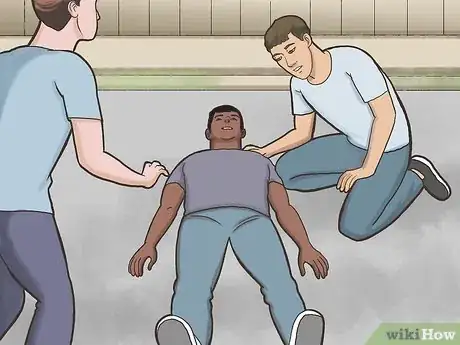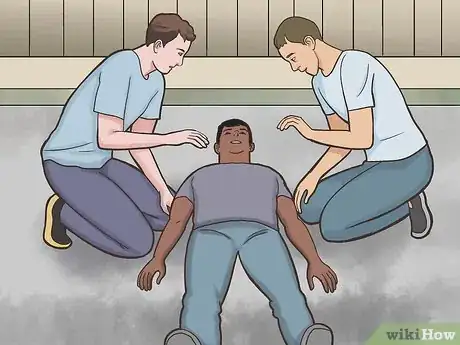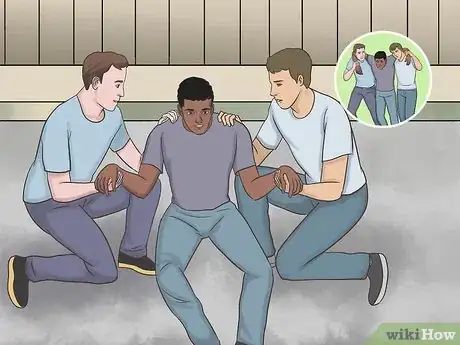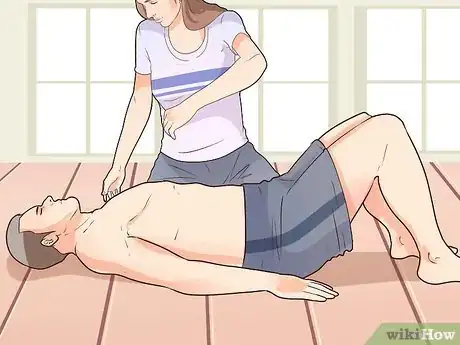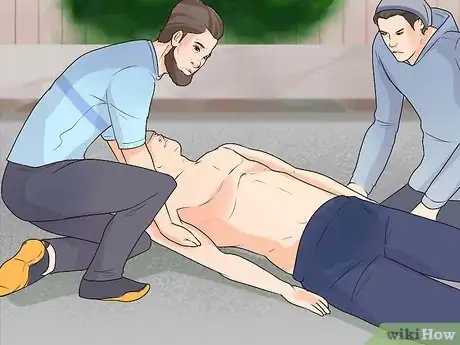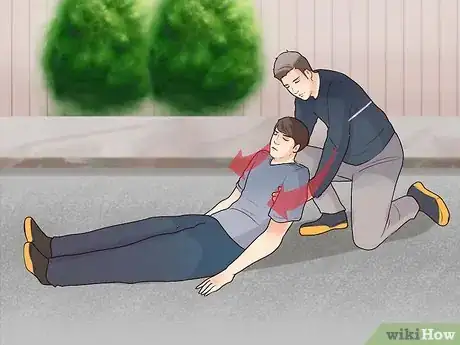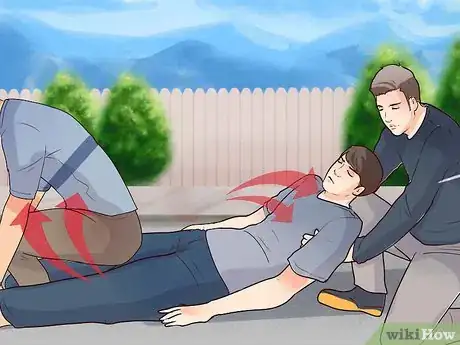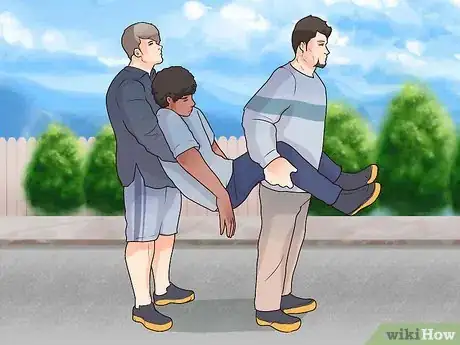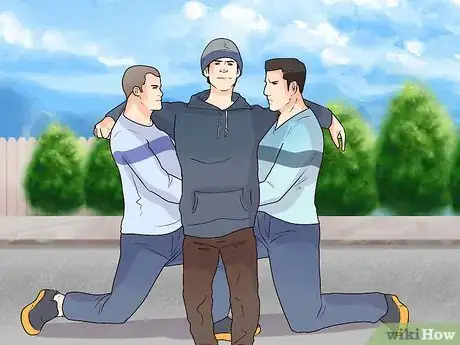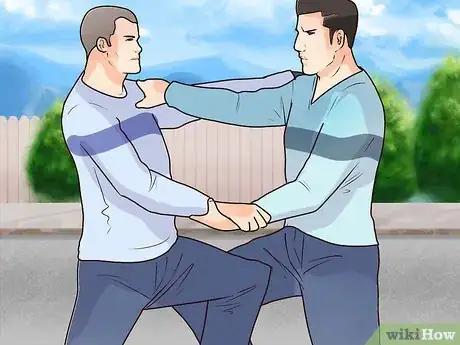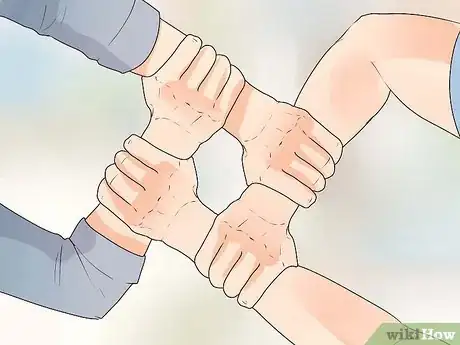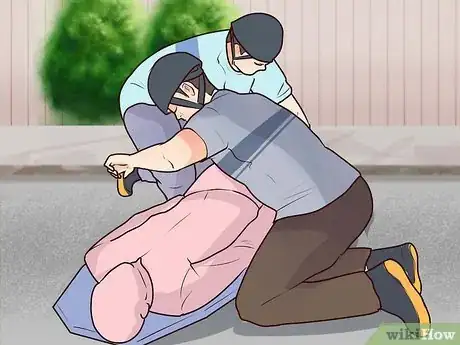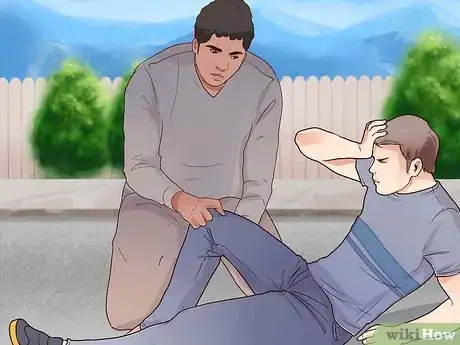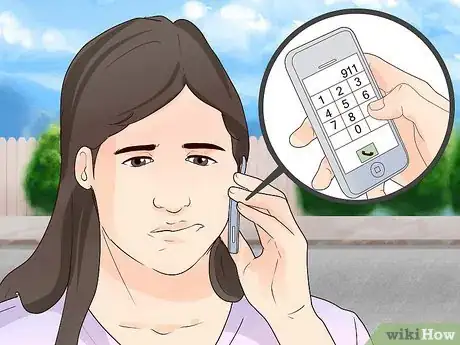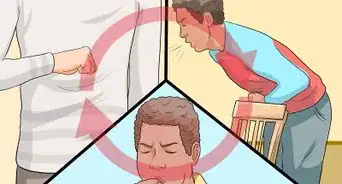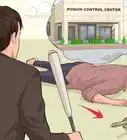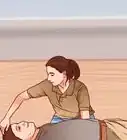This article was medically reviewed by Luba Lee, FNP-BC, MS. Luba Lee, FNP-BC is a Board-Certified Family Nurse Practitioner (FNP) and educator in Tennessee with over a decade of clinical experience. Luba has certifications in Pediatric Advanced Life Support (PALS), Emergency Medicine, Advanced Cardiac Life Support (ACLS), Team Building, and Critical Care Nursing. She received her Master of Science in Nursing (MSN) from the University of Tennessee in 2006.
This article has been viewed 94,792 times.
There are several versions of the two-person arm carry, a technique that can be used to transport an injured person to safety in the event of an emergency. You can do a simple crutch carry, carry someone from the side, or make a seat with your arms to carry an injured person. You should not attempt to perform these carries in an actual emergency without professional training, however. Changing an injured person's position could result in a serious back or neck injury. Practice at home with friends and seek out emergency training from a college or community center near you.
Steps
Crutch Carry
-
1Start with the injured person lying on their back. This simple carry is easiest if the person is lying on the ground, flat on their back.[1] If they aren’t already in this position, roll them onto their back if you can do so safely.
- This carry is easiest if the person you’re rescuing is conscious, but you can also do it with an unconscious person if you need to quickly and easily drag them out of harm’s way.[2]
-
2Crouch on either side of the person’s chest. Stand next to the injured person on one side, and have your partner stand facing you on the other side. When you’re both in position, crouch or kneel down next to the injured person.[3]
- You will need to be facing each other, rather than straight ahead, in order to pick up the person properly.
Advertisement -
3Grab the injured person’s wrist and shoulder. With the hand that’s closest to the person’s feet, grab hold of their wrist. Use your other hand to grab onto their shirt at the shoulder. Have your partner on the opposite side do the same thing.[4]
- If you can’t grab onto their clothing at the shoulder, place a hand behind their shoulder or grab them under the arm.
-
4Help the person stand if they are conscious. While holding onto the injured person’s wrists and shoulders, work with your partner to pull them into a sitting position. From there, help them stand up.[5]
- If the person is unconscious, sit them up, but don’t pull them into a standing position yet.
-
5Wrap the person’s arms around each of your shoulders and grab their waist. Once you have the person standing, guide their arm around the back of your neck and over your shoulder. Wrap your other arm around their waist. Have your partner do the same thing on the other side.[6]
- As you do this, bend your knees and crouch down slightly, then straighten up into a standing position.
- If the person is unconscious, put their arm around your shoulders and grab their waist before pulling them up into a standing position.
-
6Help the person walk while supporting their weight. Once you’re confident that you have the person well supported, you and your partner can start walking. Make sure you are all facing the same direction.[7]
- If the injured person is conscious, they may be able to walk with your assistance.
- If they are unconscious, you’ll need to pull them along while their legs drag slightly behind them. In this case, hold onto the person’s belt or waistband for extra support.[8]
- You can also provide extra support by holding the person’s wrist with your outer hand.
Side Carry
-
1Position the injured person on their back. This helps get the injured person in the correct position to be carried. You should carry someone from the side if they’re unresponsive or unable to move. It's usually safer to carry someone in a sitting position, but this is not always possible if the person is unable to change positions. It's safer, in this case, to carry the injured person from the side.[9]
- Go slowly to avoid further injury. If the injured person is able to talk, check in frequently to make sure they are comfortable throughout the process.
- In the event the injured person is unconscious, you may want to tie their hands loosely together at the wrists. This can make the carrying process easier. If you have something that can be used to tie the injured person's hands, like thick rope or a bandana, you can use this.
- Do not use anything thin or sharp to tie the person's hands—this could cut their wrists.
-
2Position yourself and a partner next to the injured person. From here, you and your partner should each stand on the side of the injured person. One person should stand near the injured person's shoulders and the other should stand near their knees. Both of you should bend down on one knee so you're level with the injured person.[10]
-
3Take hold of the injured person at the shoulder, waist, hips, and knees. From here, you and your partner can take hold of the injured person. Depending on where you're standing, you'll need to take hold of different parts of the injured person.
-
4Shift the weight of the injured person. From here, shift the weight of the injured person into your and your partner's arms. In unison, you and your partner should shift your weight backwards. Lift the injured person up together, until they are level with your and your partner's knees. Still working in unison, turn the injured person in towards your chests.[13]
-
5Stand in unison with your partner. From here, rise to your feet along with your partner. Make sure you and your partner are communicating so you lift at the same time, so as not to jostle or otherwise disturb the injured person. As you stand, make sure to carry the injured person high up, towards both of your chests.[14]
- Lift with your legs, not your back. If you're truly the only people who can help the person, you mustn't hurt yourselves in the process!
- In the event that the injured person is very heavy, you may need to have another person assist in supporting their weight.
Two or Four-Hand Seat Carry
-
1Get in position by kneeling on either side of the injured person. It may be easier, safer, and more comfortable for the injured person to lift them by creating a seat with your and your partner's arms. If you're carrying someone who's able to move into a seated position, make a seat for them. You can do so with 2 hands or 4 hands. Regardless of the position you're using, you start in the same position.
-
2Create a two-handed seat for an unconscious person. If an injured person is unconscious, use a two-handed seat. To do this, you and your partner should each place one hand below the injured person's shoulders and one hand below their knees. Then, grasp one another's wrists, forming a hammock-like seat for the injured person.[17]
- Stand together in unison. Make sure to communicate with your partner so you're standing at the same time to avoid jostling the injured person.
- When walking, walk in the direction the injured person is facing.
-
3Try a four-handed seat if the injured person is conscious. The four-handed seat requires participation from the injured person. It should only be used if the injured person is conscious and able to assist. To start, grab your own left wrist with your right hand. Have your partner do the same. Then, grab your partner's right wrist with your left hand. Your partner will grab your right wrist with their left hand. This creates a square-shaped seat with your arms.[18]
- Have the injured person shift to the sitting position. You and your partner should lower your bodies, bringing the seat you've created down near the injured person's bottom.
- Have the injured person sit on your forearms. Then, ask them to place their arms on your and your partner's shoulders for balance.
- Again, lift slowly and in unison. Walk in the direction the injured person is facing.
Precautions
-
1Get professional training before attempting an actual rescue. While it can be fun to practice various carrying techniques with a friend, you should not attempt to perform them on an injured person without professional training. Enroll in a first aid course, nursing course, or a course on emergency or disability services if you want to be able to perform these techniques on someone who's injured or incapacitated. You should have some kind of professional certification before attempting any of these techniques.
- Without professional training, it can be hard to assess the extent of someone's injuries. You may be unsure which carry to use if you're unable to tell if it's safe to move someone in a particular position.
- Carrying someone safely requires a great deal of practice and guidance. Practice carrying someone with the supervision of a professional, who can correct your form and provide tips. Professional training can help you learn how to conduct yourself safely during an emergency.
- However, if you think the person is in immediate danger—for example, if they’ve collapsed in the middle of a busy street—you may have to move them in order to get them out of harm’s way.[19]
-
2Ask how you can help first. If someone is injured or disabled, don't jump to performing one of the above techniques. If the person is conscious, ask them how they should be moved, and check if they have any special needs or considerations you should keep in mind. An injured or disabled person may also be waiting on professional services, and may not need the help of you and your partner. It's always better to ask first, if possible.
-
3Call 911 in the event of life-threatening injuries. If a person has life-threatening injuries, call 911 or your local emergency number immediately. Do not attempt to move the person unless you are advised by an emergency dispatcher to do so.
Warnings
- Do not perform these carries on anyone who may have suffered a head or spinal injury. If at all possible, do not move the person at all; but if the victim must be moved, immobilize their head and make a litter or stretcher to keep spine in alignment.⧼thumbs_response⧽
References
- ↑ https://www.cert-la.com/cert-training-education/lifts-carries/
- ↑ https://www.asgmag.com/survival-skills/moving-the-wounded-methods-for-patient-transport-in-survival-settings/
- ↑ https://www.cert-la.com/cert-training-education/lifts-carries/
- ↑ https://www.cert-la.com/cert-training-education/lifts-carries/
- ↑ https://www.cert-la.com/cert-training-education/lifts-carries/
- ↑ https://www.asgmag.com/survival-skills/moving-the-wounded-methods-for-patient-transport-in-survival-settings/
- ↑ https://www.cert-la.com/cert-training-education/lifts-carries/
- ↑ https://www.asgmag.com/survival-skills/moving-the-wounded-methods-for-patient-transport-in-survival-settings/
- ↑ http://www.medtrng.com/cls/lesson_15_2.htm
- ↑ http://www.medtrng.com/cls/lesson_15_2.htm
- ↑ http://www.medtrng.com/cls/lesson_15_2.htm
- ↑ http://www.medtrng.com/cls/lesson_15_2.htm
- ↑ http://www.medtrng.com/cls/lesson_15_2.htm
- ↑ http://www.medtrng.com/cls/lesson_15_2.htm
- ↑ http://www.medtrng.com/cls/lesson_15_2.htm
- ↑ http://www.medtrng.com/cls/lesson_15_2.htm
- ↑ https://www.asgmag.com/survival-skills/moving-the-wounded-methods-for-patient-transport-in-survival-settings/
- ↑ https://www.asgmag.com/survival-skills/moving-the-wounded-methods-for-patient-transport-in-survival-settings/
- ↑ https://www.wta.edu.au/learning/moving-a-casualty-when-and-how-should-you-do-it/
- ↑ https://www.cert-la.com/cert-training-education/lifts-carries/
About This Article
To do a two-person arm carry for moving an injured person, start by having the injured person lie on their back. You and your partner should kneel down on either side of the injured person and face each other. If the person is unconscious or unable to sit up, you and your partner should make a two-handed seat. Place one hand below the injured person’s shoulders and the other hand below their knees, and then grasp one another’s wrists to form a hammock-like seat. Stand together at the same time to lift the person, and make sure to communicate with your partner so your movement is in unison to avoid jostling the injured person. For more tips, like how to make a four-handed seat for a conscious injured person, keep reading!
